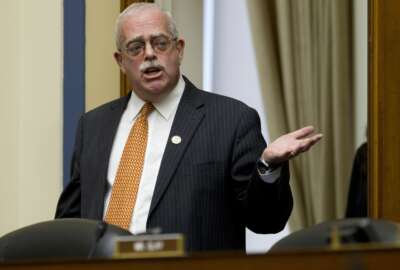
Agency approaches vary widely, as federal telework participation dips governmentwide in 2017
Participation in federal telework programs fell slightly in 2017, according to the latest data from the Office of Personnel Management's report to Congress.
Federal employees spent less time teleworking in 2017 than they did during the previous year, according to the most recent annual report on the topic from the Office of Personnel Management.
For eligible employees, federal telework participation went down from 51% to 48% in 2017, according to OPM’s latest telework status report from fiscal 2017 to Congress. Participation also dropped slightly across government from 22% to 21% of the federal workforce.
It’s unclear exactly when OPM released the fiscal 2017 report, but it’s dated January 2019.
But what OPM’s latest report shows perhaps most clearly is just how much federal telework use — and the approaches agency supervisors and top management use to encourage and expand participation within their organizations — varies across government.
“When implemented as a strategic management tool, robust and well-practiced telework programs improve staff performance and engagement and maximize organizational mission productivity, efficiency and government stewardship,” Margaret Weichert, OPM’s acting director, said in the 2017 report. ”
Slightly more federal employees — about 43% of the workforce — were eligible to telework in 2017, compared with 42% of employees in 2016.
Despite the slight bump in eligibility, agencies reported a total of 469,810 teleworkers in 2017, compared with 477,084 employees in 2016.
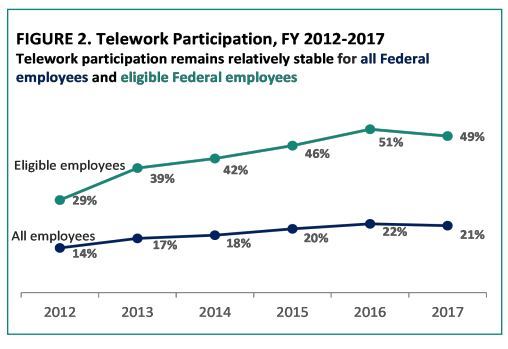
The decrease is due to several factors, including attrition and fewer situational telework events such as inclement weather closures. OPM in fiscal 2016 announced 10 total days of unscheduled federal telework, including three government closures in the Washington, D.C., metropolitan area but only one day of unscheduled federal telework in 2017.
“Agencies face significant challenges in aligning their systems to collect and transmit accurate telework data,” OPM said. “In fiscal 2017, most agencies relied on data from their time and attendance systems — 75% of agencies — to track telework participation. Nevertheless, various factors limit telework data quality assurance, including employees incorrectly teleworking and managers not correcting these errors, and time sheets misaligned with reporting requirements, and tracking technology limitations.”
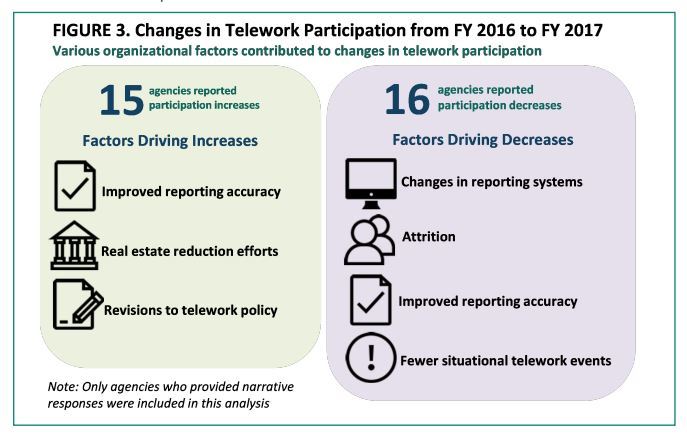
Many agencies also attributed changes in participation to recent adjustments that OPM made in what it considers “telework.”
Participation at the General Services Administration, for example, appeared to drop 4% in 2017 because of OPM’s decision to exclude “remote workers” from the telework category. If “remote workers” were still considered “teleworkers,” GSA said it would have seen participation go up another 1% last year.
“Remote workers” are employees who regularly work from another approved location but return to the worksite at least once every two weeks. Some agencies refer to these employees as “full time teleworkers,” but OPM maintains that departments shouldn’t consider these individuals as “teleworkers.”
Both the CIA, which allows its employees to use flexible work sites due to access restrictions with classified information, and the Patent and Trademark Office also saw telework participation decline for this reason.
The latest telework status update comes after at least two large departments announced changes to their own programs. The Agriculture Department in early 2018 announced plans to limit telework to one day a week. Before, eligible employees had essentially an unlimited access to telework. Similarly, the Education Department also told employees it would limit telework to one day a week for eligible employees.
The impact of these moves, however, can’t be seen in OPM’s latest telework update, since its report only covers fiscal 2017, and the two agencies announced changes to their respective programs in fiscal 2018.
More employees did become eligible to telework at USDA over 2017. According to OPM’s update, 62,744 employees were eligible in 2017, compared with 58,635 during the previous year.
In addition, several agencies have updated their time and attendance systems and are automatically reporting telework data, though many are still struggling, OPM said. Telework participation fell a percentage point over the year.
Nearly all employees at the Education Department were eligible to telework in 2017, but participation appears to have declined based on attrition. In 2017, Education had 4,045 employees out of a workforce of 4,068 who were eligible for telework, compared with 4,358 eligible employees out of a workforce of 4,358 in 2016. Based on the agency’s workforce numbers in this telework report alone, Education appears to have lost 8% of its employees in 2017.
Other agencies saw more pronounced changes in telework participation in 2017. 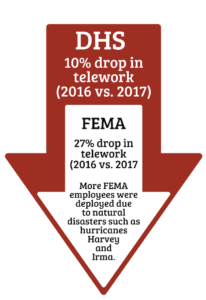
The Department of Homeland Security, for example, saw a 10% drop in telework participation. The department attributed the decline to changes at its component agencies. Telework participation dropped 27% at the Federal Emergency Management Agency. The agency attributed the stark change to an increasing number of employees who were deployed to work in the field after Hurricanes Harvey and Irma and the wildfires in California.
Other agencies, however, saw telework participation increase in 2017, particularly because of concerted efforts that management made to boost employee awareness of their programs.
The Department of Housing and Urban Development, for example, included telework training as part of new employee orientation programs in 2017. HUD said many new employees decided to immediately participate in telework after orientation, boosting the department’s eligibility rate to 81%.
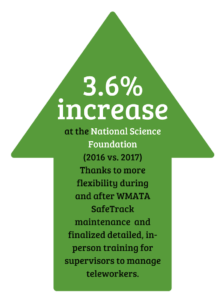 Telework participation at the National Science Foundation went up 3.6% in 2017 because the agency added special training for supervisors to manage teleworking employees and their performance. In addition, NSF added more telework flexibilities during the Washington Metropolitan Area Transit Authority several month-long stretch of repairs on certain metro lines. NSF continued many of those telework flexibilities even after the repair work ended.
Telework participation at the National Science Foundation went up 3.6% in 2017 because the agency added special training for supervisors to manage teleworking employees and their performance. In addition, NSF added more telework flexibilities during the Washington Metropolitan Area Transit Authority several month-long stretch of repairs on certain metro lines. NSF continued many of those telework flexibilities even after the repair work ended.
The Securities Exchange Commission began a “telework effectiveness” project in 2017. It offered 17 additional telework training courses for employees and celebrated “telework week” that year by distributing additional information to employees about how they could utilize the program and best track their use on SEC’s time and attendance systems. About 91% of SEC employees used the agency’s time and attendance system to indicate telework participation in 2017, compared to 64 percent in 2016.
Meantime, other agencies saw some success in realizing and reporting the benefits of telework.
NASA’s Johnson Space Center in Texas, for example, allowed employees to use “flex Friday” schedules and a “work for anywhere” policy to help conserve energy at some of the center’s facilities. These programs allowed NASA to place some non-critical buildings in “weekend mode” with the lights and air conditioning turned off, leading to $85,000 in savings a year in utility costs.
The Court Services and Offender Supervision Agency set a goal of measuring how many miles its employees save on average by using telework. The agency estimated its employees commute an average of 38.4 miles a day round-trip to work. Employees saved 878,349 commuting miles over one year through telework.

Despite the wide variances in agency approaches to the program, employee attitudes toward federal telework improved over the year. About 63 percent of employees had a positive view of the program in 2017, compared with 55 percent in 2016.
OPM has previously found that employees who telework or use one of the available government work-life programs are generally happier and more engaged — and receive higher performance results — compared to employees who do not or cannot take advantage of those offerings.
Specifically, federal employees who telework or participate in one of their agency’s wellness programs are more likely to receive a rating of “exceeds fully successful” on their last performance appraisal than those who did not participate in one of these programs, according to OPM’s inaugural study of government work-life programs. About 76 percent of teleworking employees reported high performance ratings compared to 72 percent of non-teleworking employees.
In addition, employees who engaged in telework, work flexibilities or health and wellness programs were significantly more satisfied with their jobs. Anywhere from 75 to 79 percent of employees who participated in one of these programs said they were happy with their jobs, compared to 67 to 72 percent of federal workers who didn’t engage with these programs.
Graphics by Amelia Brust
Copyright © 2025 Federal News Network. All rights reserved. This website is not intended for users located within the European Economic Area.
Nicole Ogrysko is a reporter for Federal News Network focusing on the federal workforce and federal pay and benefits.
Follow @nogryskoWFED





